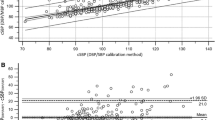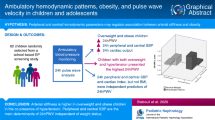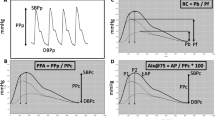Abstract
The aims were to determine whether children’s high peripheral blood pressure states (HBP) are associated with increased central aortic blood pressure (BP) and to characterize hemodynamic and vascular changes associated with HBP in terms of changes in cardiac output (stroke volume, SV), arterial stiffness (aortic pulse wave velocity, PWV), peripheral vascular resistances (PVR) and net and relative contributions of reflected waves to the aortic pulse amplitude. We included 154 subjects (mean age 11; range 4–16 years) assigned to one of two groups: normal peripheral BP (NBP, n = 101), defined as systolic and diastolic BP < 90th percentile, or high BP (HBP, n = 53), defined as average systolic and/or diastolic BP levels ≥90th percentile (curves for sex, age and body height). The HBP group included children with hypertensive and pre-hypertensive BP levels. After a first analysis, groups were compared excluding obese and dyslipidemic children. Peripheral and central aortic BP, PWV and pulse wave-derived parameters (augmentation index, forward and backward wave components’ amplitude) were measured using gold-standard techniques, applanation tonometry (SphygmoCor) and oscillometry (Mobil-O-Graph). Independent of the presence of dyslipidemia and/or obesity, aortic systolic and pulse BP were higher in HBP than in NBP children. The increase in central BP could not be explained by an increase in the relative contribution of reflections to the aortic pressure wave, higher PVR or by an augmented peripheral reflection coefficient. Instead, the rise in central BP would be explained by an increase in the amplitude of both incident and reflected wave components.

Similar content being viewed by others
References
Falkner B, DeLoach S, Keith SW, Gidding SS (2013) High risk blood pressure and obesity increase the risk for left ventricular hypertrophy in African-American adolescents. J Pediatr 162:94–100
Anyaegbu EI, Dharnidharka VR (2014) Hypertension in the teenager. Pediatr Clin North Am 61(1):131–151
Mayet J, Hughes A (2003) Cardiac and vascular pathophysiology in hypertension. Heart 89:1104–1109
Nichols W, O’Rourke M, Vlachopoulos C (eds) (2011) McDonald’s blood flow in arteries: theoretical, experimental and clinical principles. CRC Press, Boca Raton
Franklin S, Mc Eniery C, Cockcroft J, Wilkinson I (2014) Value of brachial and central blood pressure for predicting cardiovascular events. Chapter 20. In: Safar M, O’Rourke MF, Frohlich E (eds) Blood pressure and arterial wall mechanics in cardiovascular diseases. Springer, London, pp 243–256
ESH/ESC Guidelines for the management of arterial hypertension (2013) TheTask Force for the management of arterial hypertension of the European Society of Hypertension (ESH) and of the European Society of Cardiology (ESC). J Hypertens 31:1281–1357
Williams B, Lacy PS, Thom SM, Cruickshank K, Stanton A, Collier D, Hughes AD, Thurston H, O’Rourke M, CAFE Investigators, Anglo-Scandinavian Cardiac Outcomes Trial Investigators, CAFE Steering Committee and Writing Committee (2006) Differential Impact of blood pressure-lowering drugs on central aortic pressure and clinical outcomes: principal results of the Conduit Artery Function Evaluation (CAFE) study. Circulation 113(9):1213–1225
Bia D, Zócalo YA, Armentano RL (2012) Integrated e-Health approach based on vascular ultrasound and pulse wave analysis for asymptomatic atherosclerosis detection and cardiovascular risk stratification in the community. IEEE Trans Inf Technol Biomed 16(2):287–294
Bia D, Zócalo Y, Farro I, Torrado J, Farro F, Florio L, Olascoaga A, Brum J, Alallón W, Negreira C, Lluberas R, Armentano RL (2011) integrated evaluation of age-related changes in structural and functional vascular parameters used to assess arterial aging, subclinical atherosclerosis, and cardiovascular risk in uruguayan adults: CUiiDARTE project. Int J Hypertens 2011:587303
National High Blood Pressure Education Program Working Group in High Blood Pressure in Children and Adolescents (2004) The fourth report on the diagnosis, evaluation, and treatment of high blood pressure in children and adolescents. Pediatrics 114(2):555–576
WHO Multicentre Growth Reference Study Group (2006) WHO child growth standard based on length/height, weight, and age. Acta Paediatr 450:76–85
Weiss W, Tolle M, Zidek W, van der Giet M (2010) Validation of the mobil-OGraph: 24 h-blood pressure measurement device. Blood Press Monit 15(4):225–228
Hametner B, Wassertheurer S, Kropf J, Mayer C, Eber B, Weber T (2013) Oscillometric estimation of aortic pulse wave velocity: comparison with intra-aortic catheter measurements. Blood Press Monit 18(3):173–176
Papaioannou TG, Argyris A, Protogerou AD, Vrachatis D, Nasothimiou EG, Sfikakis PP (2013) Non-invasive 24 hour ambulatory monitoring of aortic wave reflection and arterial stiffness by a novel oscillometric device: the first feasibility and reproducibility study. Int J Cardiol 169(1):57–61
Shirai K, Hiruta N, Song M, Kurosu T, Suzuki J, Tomaru T, Miyashita Y, Saiki A, Takahashi M, Suzuki K, Takata M (2011) Cardio-ankle vascular index (CAVI) as a novel indicator of arterial stiffness: theory, evidence and perspectives. J Atherosc Thromb 18(11):924–938
Weber T, Wassertheurer S, Rammer M, Maurer E, Hametner B, Mayer CC, Kropf J, Eber B (2011) Validation of a brachial cuff-based method for estimating central systolic blood pressure. Hypertension 58(5):825–832
Wassertheurer S, Kropf J, Weber T, van der Giet M, Baulmann J, Ammer M, Hametner B, Mayer CC, Eber B, Magometschnigg D (2010) A new oscillometric method for pulse wave analysis: comparison with a common tonometric method. J Hum Hypertens 24(8):498–504
Hametner B, Wassertheurer S, Kropf J, Mayer C, Holzinger A, Eber B, Weber T (2013) Wave reflection quantification based on pressure waveforms alone-methods, comparison, and clinical covariates. Comput Methods Progr Biomed 109(3):250–259
Nunan D, Wassertheurer S, Lasserson D, Hametner B, Fleming S, Ward A, Heneghan C (2012) Assessment of central haemomodynamics from a brachial cuff in a community setting. BMC Cardiovasc Disord 26:12–48
Van Bortel LM, Laurent S, Boutouyrie P, Chowienczyk P, Cruickshank JK, De Backer T, Filipovsky J, Huybrechts S, Mattace-Raso FU, Protogerou AD, Schillaci G, Segers P, Vermeersch S, Weber T (2012) Artery Society; European Society of Hypertension Working Group on vascular structure and function; European network for noninvasive investigation of large arteries. Expert consensus document on the measurement of aortic stiffness in daily practice using carotid-femoral pulse wave velocity. J Hypertens 30(3):445–448
Feistritzer HJ, Reinstadler SJ, Klug G, Kremser C, Seidner B, Esterhammer R, Schocke MF, Franz WM, Metzler B (2015) Comparison of an oscillometric method with cardiac magnetic resonance for the analysis of aortic pulse wave velocity. PLoS one 10(1):e0116862
Franssen PM, Imholz BP (2010) Evaluation of the Mobil-O-Graph new generation ABPM device using the ESH criteria. Blood Press Monit 15(4):229–231
Maloberti A, Cesana F, Hametner B, Dozio D, Villa P, Hulpke-Wette M, Schwarz A, Selicorni A, Wassertheurer S, Mancia G, Giannattasio C (2015) Increased nocturnal heart rate and wave reflection are early markers of cardiovascular disease in Williams–Beuren syndrome children. J Hypertens 33(4):804–809
Milne L, Keehn L, Guilcher A, Reidy JF, Karunanithy N, Rosenthal E, Qureshi S, Chowienczyk PJ, Sinha MD (2015) Central aortic blood pressure from ultrasound wall-tracking of the carotid artery in children: comparison with invasive measurements and radial tonometry. Hypertension 65(5):1141–1146
Sibiya MJ, Woodiwiss AJ, Booysen HL, Raymond A, Millen AM, Maseko MJ, Majane OH, Sareli P, Libhaber E, Norton GR (2015) Reflected rather than forward wave pressures account for brachial pressure-independent relations between aortic pressure and end-organ changes in an African community. J Hypertens 33(10):2083–2090
Zamani P, Jacobs DR Jr, Segers P, Duprez DA, Brumback L, Kronmal RA, Lilly SM, Townsend RR, Budoff M, Lima JA, Hannan P, Chirinos JA (2014) Reflection magnitude as a predictor of mortality: the multi-ethnic study of atherosclerosis. Hypertension 64(5):958–964
Wei W, Tölle M, Zidek W, van der Giet M (2010) Validation of the Mobil-O-Graph: 24 h-blood pressure measurement device. Blood Press Monit 15(4):225–228
Weiss W, Gohlisch C, Harsch-Gladisch C, Tölle M, Zidek W, van der Giet M (2012) Oscillometric estimation of central blood pressure: validation of the Mobil-O-Graph in comparison with the SphygmoCor device. Blood Press Monit 17(3):128–131
Castro JM, García-Espinosa V, Curcio A, Arana M, Chiesa P, Giachetto G, Zócalo Y, Bia D (2016). Childhood obesity associates haemodynamic and vascular changes that result in increased central aortic pressure with augmented incident and reflected wave components, without changes in peripheral amplification. Int J Vasc Med, ID 3129304. doi:10.1155/2016/3129304
Bhat DP, Gupta P, Aggarwal S (2015) Elevated aortic augmentation index in children following fontan palliation: evidence of stiffer arteries? Pediatr Cardiol 36(6):1232–1238
Ellis D, Miyashita Y (2011) Primary hypertension and special aspects of hypertension in older children and adolescents. Adolesc Health Med Ther 2:45–62
Vlachopoulos C, Aznaouridis K, O’Rourke MF, Safar ME, Baou K, Stefanadis C (2010) Prediction of cardiovascular events and all-cause mortality with central haemodynamics: a systematic review and meta-analysis. Eur Heart J 31:1865–1871
Totaro S, Khoury PR, Kimball TR, Dolan LM, Urbina EM (2015) Arterial stiffness is increased in young normotensive subjects with high central blood pressure. J Am Soc Hypertens 9(4):285–292
Agabiti-Rosei E, Mancia G, O’Rourke MF, Roman MJ, Safar ME, Smulyan H, Wang JG, Wilkinson IB, Williams B, Vlachopoulos C (2007) Central blood pressure measurements and antihypertensive therapy: a consensus document. Hypertension 50(1):154–160
Elmenhorst J, Hulpke-Wette M, Barta C, DallaPozza R, Springer S, Oberhoffer R (2015) Percentiles for central blood pressure and pulse wave velocity in children and adolescents recorded with an oscillometric device. Atherosclerosis 238(1):9–16
Mitchell GF, Wang N, Palmisano JN, Larson MG, Hamburg NM, Vita JA, Levy D, Benjamin EJ, Vasan RS (2010) Hemodynamic correlates of blood pressure across the adult age spectrum: noninvasive evaluation in the Framingham heart study. Circulation 122:1379–1386
Wallace S, Yasmin McEniery C, Maki-Petaja K, Booth A, Cockcroft J, Wilkinson I (2007) Isolated systolic hypertension is characterized by increased aortic stiffness and endothelial dysfunction. Hypertension 50:228–233
Sorof J, Daniels S (2002) Obesity hypertension in children: a problem of epidemic proportions. Hypertension 40:441–447
Hanevold C, Waller J, Daniels S, Portman R, Sorof J (2004) The effects of obesity, gender, and ethnic group on left ventricular hypertrophy and geometry in hypertensive children: a collaborative study of the International Pediatric Hypertension Association. Pediatrics 113(2):328–333
Reusz GS, Cseprekal O, Temmar M, Kis E, Cherif AB, Thaleb A, Fekete A, Szabo AJ, Benetos A, Salvi P (2010) Reference values of pulse wave velocity in healthy children and teenagers. Hypertension 56:217–224
Urbina EM, Khoury PR, McCoy C, Daniels SR, Kimball TR, Dolan LM (2011) Cardiac and vascular consequences of pre-hypertension in youth. J Clin Hypertens (Greenwich, Conn) 13(5):332–342
Lurbe E, Torro I, Garcia-Vicent C, Alvarez J, Fernandez-Fornoso JA, Redon J (2012) Blood pressure and obesity exert independent influences on pulse wave velocity in youth. Hypertension 60:550–555
Eng J (2003) Sample size estimation: how many individuals should be studied? Radiology 227(2):309–313
Hashimoto J, Ito S (2010) Pulse pressure amplification, arterial stiffness, and peripheral wave reflection determine pulsatile flow waveform of the femoral artery. Hypertension 56(5):926–933
Acknowledgments
This work was supported by the Agencia Nacional de Investigación e Innovación (ANII) and Espacio Interdisciplinario (EI) and Comisión Sectorial de Investigación Científica (CSIC-Udelar) of the Republic University, Uruguay. Additionally, this work was supported by extrabudgetary funds generated by CUiiDARTE Centre and Project. Professor Dr. Yanina Zócalo and Professor Dr. Daniel Bia are the Clinical Director and General Director (resp.) of CUiiDARTE Centre and Project.
Author information
Authors and Affiliations
Corresponding author
Ethics declarations
Conflict of interest
The authors declare that there is no conflict of interest regarding the publication of this paper.
Rights and permissions
About this article
Cite this article
García-Espinosa, V., Curcio, S., Marotta, M. et al. Changes in Central Aortic Pressure Levels, Wave Components and Determinants Associated with High Peripheral Blood Pressure States in Childhood: Analysis of Hypertensive Phenotype. Pediatr Cardiol 37, 1340–1350 (2016). https://doi.org/10.1007/s00246-016-1440-5
Received:
Accepted:
Published:
Issue Date:
DOI: https://doi.org/10.1007/s00246-016-1440-5




